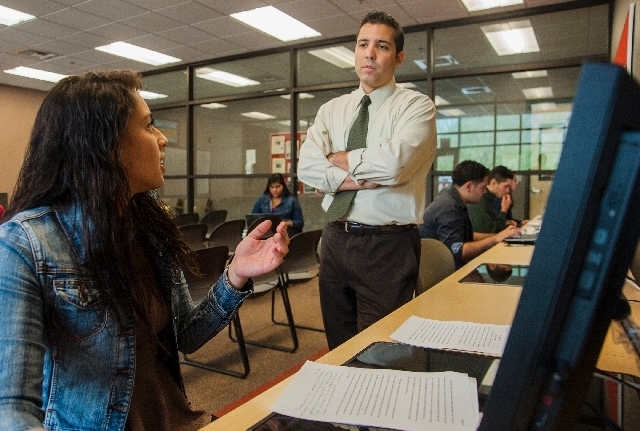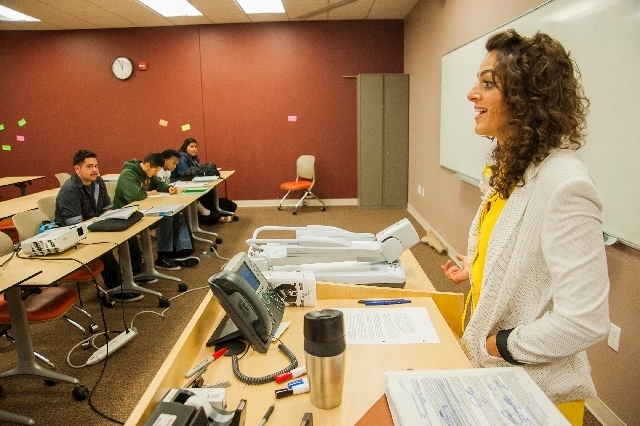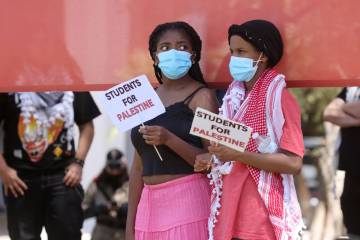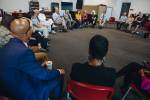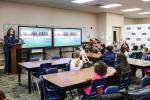Nepantla Scholars navigate the ‘in-between’ at Nevada State College
When a guest speaker recently challenged a room full of Nevada State College Nepantla Scholars to write a poem about their roots, Carolina Rojas, 18, decided to deliver a special message to her peers. So she rapped it.
“I just wanted to do that so that the kids could have an open mind that you can be open and you can be yourself,” she explained.
Rojas is one of 23 first-generation collegegoers enrolled in the program, the first of its kind in Nevada, according to Nicholas D. Natividad, assistant professor of criminal justice at Nevada State College and co-founder and director of the school’s Nepantla Program.
Nepantla includes a summer bridge program designed to help students make the transition from high school to college.
Natividad arrived at the school a year ago and worked with Edith Fernandez, now district director for Rep. Steven Horsford’s office, on a program that would empower first-generation, low-income, underserved and underrepresented students to take control of their education and careers, make confident decisions about their future and achieve their dreams. The first step: making them feel comfortable about going to college.
The word “nepantla” is an Aztec term often used to describe the space navigated by Latinos in the United States, Natividad said. It’s the “in-between” or “in the middle” place of having to speak two languages, crossing between citizenship and noncitizenship and navigating culture — “Tacos or hamburgers?” The Aztecs offered a profound example, “stuck in that space in between the conquest and their indigenous ways,” he explained.
Hispanics embody a large segment of Clark County’s student population, at 43.4 percent for the 2011-2012 school year, according to Population Reference Bureau information Natividad cited. But college retention and graduation rates aren’t reflecting a bright enough future for those students.
Natividad knows from his own experience, growing up in a predominantly Hispanic community in El Paso, Texas, about the stigma carried by certain populations when it comes to higher education. For him, that included ideas about college as an “ivory tower” reserved only for the special.
That idea changed, he said, when he got to New York to pursue his education and heard professors saying: “The professors, the staff, the administration, they work for you. You’re paying them for a service. Don’t let anyone talk down to you.”
“How can we help you?” can sound like an alien tongue to many of the students, according to Leila Pazargadi, assistant professor of English and teacher of this summer’s English 100 class. She also is director of the summer bridge program, with years of bridge program experience at places such as UCLA and the Netherlands’ Free University Amsterdam.
In December, Natividad wrote the College Access Challenge Grant that is making the Nepantla Program possible. It was accepted in January.
Seventy-two students applied for the summer bridge portion of the program, which began at the end of June and extended for six weeks.
Twenty-three students, known as Nepantla Scholars, were enrolled on scholarships.
They jump-started their success in school through math and English 100 courses, intensive tutoring, constant engagement with professors, and a steady diet of guest speakers, workshops, and assistance in everything from career and professional development and financial aid, to test anxiety.
Summer bridge participants had recently graduated from local high schools, including Basic, Rancho, Eldorado, Chaparral and Sunrise Mountain.
According to Natividad, the students ranged from ethnic minorities and low-income Caucasians to one mother straight out of high school and another student who was formerly homeless.
For Rojas, one of eight children and caretaker of her siblings in a single parent household, the program has made possible a dream that she thought was beyond her reach financially.
“I have told God, ‘Wherever you want me to go is where I’m gonna go,’ ” she said. “That way he’ll give me a sign.”
She got her sign after bumping into Joey Lopez in the hall at Basic High School. Lopez was doing outreach for the program. While the offers from other schools, including UNLV and UNR, were piling up, she made her decision.
“I’m not interested in being in an auditorium with 200, 300 kids,” she said. “I’m more of a person that likes to be in a small classroom with engaging students, an engaging professor that loves to teach, and they’re there for a reason, not for the money.”
Rojas hopes to work as a nurse in an emergency room, where she can reassure patients that they will get good care. She plans on becoming a role model for both kids and adults.
In fact, the point of the Nepantla Program isn’t merely to bolster a student’s capacity to find a job and make more money, although studies show that more education often yields those benefits. The point is to create leaders and ambassadors, whether they are supporting classmates, talking to a little sister, or fighting for community change, according to Natividad.
“The purpose of higher education is to go back and give to your community,” he emphasized, adding that many colleges and universities are shifting toward that same perspective.
The Nepantla Program will also offer more options, by providing the support students need to eventually progress to advanced degrees. And the social credibility that comes with initials such as J.D. and Ph.D. can make the difference in navigating worlds, whether the task is getting government officials to listen, or joining the ranks of “job creators” on the Las Vegas scene.
Many young people in the area are the sons and daughters of parents who came to Las Vegas in pursuit of low-skill jobs, Natividad said. But the local economic picture is shifting, leaving even fewer options for kids who were once expected to follow in their parents’ footsteps. It’s a nepantla scenario.
The program’s curriculum offers a solution: critical thinking.
“The innovation and entrepreneurship start to flow from that,” Natividad said. “We don’t want to create little robots that are going to go on and just do whatever work they need to. We want to create the students and the leaders that then create the jobs, create the innovation, create the technology.”
Yet another aspect of the “in-betweenness” addressed by the program, said Pazargadi, is the huge gulf she has noticed between high school and college-level skills in the valley. That gap wasn’t as glaring in her work with underserved students elsewhere, including California.
That’s where a tough curriculum comes in, one that helps build self-esteem and a sense of identity. The freshman year experience includes both ethics classes taught by Natividad and English 102, taught by Pazargadi. Both classes zero in on social justice, race, class, gender, social movements, resistance and discrimination.
Pazargadi also insists on teaching post-colonial theory in literature, a subject that has unhinged many a graduate student.
“We start to build the self-esteem around the curriculum,” she said. “And it is incredible. Right now I can tell you that they’re outperforming some of our seniors because we’re working with them so intensively.”
When a student approached Natividad and mentioned that she thought she had been placed in the program because she was “just stupid,” his response: “The complete opposite. You’re in this program because we think you have the ability to succeed better than anyone else.”



